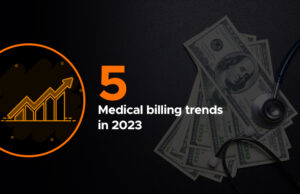Medical Billing: An Overview
Medical billing is a vital part of the healthcare industry, but it is also a dynamic and complex one. As technology advances, regulations change, and patient expectations grow, medical billing professionals must adapt and innovate to meet the market’s demands. In this editorial, we will explore five of the most important and exciting trends that are shaping the future of medical billing in 2023 and beyond.
According to BSI Medical Billing, the medical billing industry is expected to grow by 9.52% by 2026. Currently, 75% of providers use paper and manual processes for billing, but new advancements in technology are expected to shift those numbers toward cloud-based and online billing. Additionally, 87% of consumers want to make their payments in one place: online.
Here are the top 5 medical billing trends to watch in 2023:
-
The Rise of Artificial Intelligence (AI)
The healthcare industry is being transformed by the rapid advancements in artificial intelligence (AI), and medical billing is one area that is seeing significant changes. AI technologies such as natural language processing (NLP) are being used to automate the coding of medical records, leading to increased efficiency and reduced errors. This can result in time and cost savings for healthcare providers.
As we move into 2023 and beyond, we can expect to see even more AI-powered solutions implemented in medical billing. These solutions will continue to automate tasks, increase efficiency, and reduce errors, leading to a more streamlined and effective medical billing process that benefits healthcare providers and patients.
According to a report by CB Insights Research, AI can help optimize backend systems such as filing claims or medical coding, which are one of the leading costs for healthcare systems and causes of burnout. Recent progress in the field of NLP is helping to make the billing and insurance process more efficient. Language models from companies such as Google and OpenAI have contributed to considerable advancements in understanding medical records. Open-source NLP tools that focus on healthcare have been made available for developers. Examples include Amazon Comprehend Medical and Google’s Healthcare Natural Language API.
-
The Growth of Telemedicine
Telemedicine, which refers to the use of telecommunications technology to provide healthcare services remotely, has seen a surge in popularity in recent years, particularly due to the COVID-19 pandemic. In 2023 and beyond, we expect to see continued growth in the use of telemedicine.
Telemedicine can help improve access to healthcare, reduce costs, and improve patient satisfaction. For example, telemedicine can provide virtual visits with doctors, which can be convenient for patients who live in rural areas or have difficulty getting to a doctor’s office.
The CDC reports that telehealth visits in the U.S. rose by 154% in the first quarter of 2020 compared to the same time frame in 2019. It is anticipated that the adoption of telemedicine will keep increasing in the future.
-
The Increased Focus on Patient Experience
In the healthcare sector, the experience of patients is gaining more and more significance. Patients are more likely to choose healthcare providers that offer a positive patient experience. In 2023, we expect healthcare providers to focus more on improving the patient experience.
There are several ways to improve the patient experience, such as providing clear and concise communication, making the billing process easy to understand, and offering convenient payment options. By focusing on the patient experience, healthcare providers can attract and retain more patients.
-
The Demand for Transparency
Patients are indeed demanding more transparency from healthcare providers. Patients want to know how much their care will cost, and they want to be able to understand the billing process. In 2023, we expect healthcare providers to provide more transparency to patients.
There are many ways to provide more transparency to patients, such as posting prices online, providing itemized bills, and explaining the billing process in detail. Healthcare providers can build patient trust and improve the patient experience by providing more transparency.
-
The Need for Compliance
The healthcare industry is highly regulated, and healthcare providers must comply with various regulations. In 2023, we expect to see an increased focus on compliance in the medical billing space.
There are several ways to ensure compliance, such as using certified medical billing software, hiring a qualified medical billing professional, and staying up-to-date on the latest regulations. By ensuring compliance, healthcare providers can protect themselves from penalties and fines.
The American Hospital Association’s Regulatory Overload Report states that healthcare organizations allocate $39 billion annually to meet 629 federal regulatory mandates.
These are just a few top medical billing trends to watch in 2023. By staying up-to-date on these trends, healthcare providers can improve their billing processes and provide a better patient experience.
Conclusion
Medical billing is a dynamic and complex field that requires constant adaptation and innovation. In 2023, we expect to see more use of artificial intelligence, telemedicine,and patient experience. Additionally we expect to see a rise in transparency, and compliance in the medical billing industry. These trends will help improve the efficiency, accuracy, and quality of medical billing services for healthcare providers and patients.







